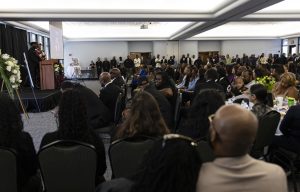Gonzalez announces plans to renovate residence halls
October 29, 2003
President Alexander Gonzalez announced university plans torenovate the entire residential hall complex Friday.
Gonzalez expects developers to take 3-4 months to submitproposals for the project. Each proposal will then be evaluated andthe school will decide whether to proceed with their plans.
Associated Students, Inc. President Peter Ucovich said buildingnew dorms has been talked about for the past eight years withdiscussions becoming more intense three years ago.
Beginning with Foley Hall, the plans call for each hall to betorn down and replaced with five-story, apartment-style structures.The new facilities would provide an alternative to off-campusliving and would foster a sense of community on campus, Gonzalezsaid.
The six new structures would hold 4,500-5,000 residents, asignificant increase from the current population of 1,100. Gonzalezsaid the plan would include a new parking structure for residentsand possibly a new Dining Commons.
“Having that many students on the campus changeseverything,” Gonzalez said. “We would have to gear upto have the activities and amenities it would take to service thatmany students.”
Gonzalez said he is looking at a different approach to financethe new complex, since the university is dealing with a budgetcrunch.
“This is going to be unique,” he said. “In theold days, what you’d do is build it with the revenue fundfrom the Chancellors’ Office for the dorms. What we’relooking at is developing a partnership with the builders and maybelooking at third-party financing.”
Gonzalez compared the plans to the residential apartments thatwere built at San Marcos State, where he served as president from1997-2002.
San Marcos State did not have to put any money down for their$28 million 469-resident apartments, called University Village. Thedevelopers, Allen & O’Hara Inc., built the complex onland owned by the state. Allen & O’Hara will own theapartments for 30 years, collect rent from residents and then turnover ownership to the university.
University Village opened Aug. 30 and consists mostly ofsingle-room bedrooms, a bathroom for every two rooms and a commonliving room and kitchen for every four rooms. The apartmentsaverage around 1,100 square feet and residents pay $572-$689 amonth for the academic year.
David Lee, hall director for Sierra and Sutter halls, has spentthe last two years helping supervise overflow housing for theresidential halls. He said about 200 students were on a waitinglist for a room when the halls opened each year.
“We have constantly accommodated students for the last twoyears,” Lee said. “(Housing and Residential LifeDirector) Cynthia Cockrill has done a good job and has been verysympathetic and empathetic to incoming residents, trying to findthem housing and constantly working on a waiting list.”
“The increase in housing space is a great idea,” hesaid. “Sacramento State, being the capital campus, is ahighly-known college and just for the last couple of years you seethe enrollment increase.”
Lee said he was very appreciative of Gonzalez’sacknowledgement that an increase in population would change thedynamics and needs of the campus.
Sociology major Megan Gordon, a junior from Lititz, Penn., likesthe idea of increasing the residential hall population.
“It will great,” she said. “Since this is acommuter college, it will help people feel more united as acampus.”
Undeclared freshman Macaulay Hutchinson is also in favor of thenew complex.
“I have a lot of friends who live in temporary housing anddon’t get to move out until months into the semester,”he said. “It would provide a lot more housing for the peopleon the waiting list, especially for freshmen who should live oncampus for their first year to get adjusted.”
Adam Wooden, a kinesiology major in his junior year, said hequestions why the school wants to attract more people.
“They are already slashing classes, so if they are addingmore people in the dorms and slashing class sizes, it seems to becontradictory to each other,” he said.
Wooden said he is also concerned that construction would have anegative impact on students already living in the dorms.
“It would be detrimental for students to have to live,work and eat in the shadow and dust of a construction site,”he said. “How do you study or relax when heavy machinery anddust fill the air?”
























































































































